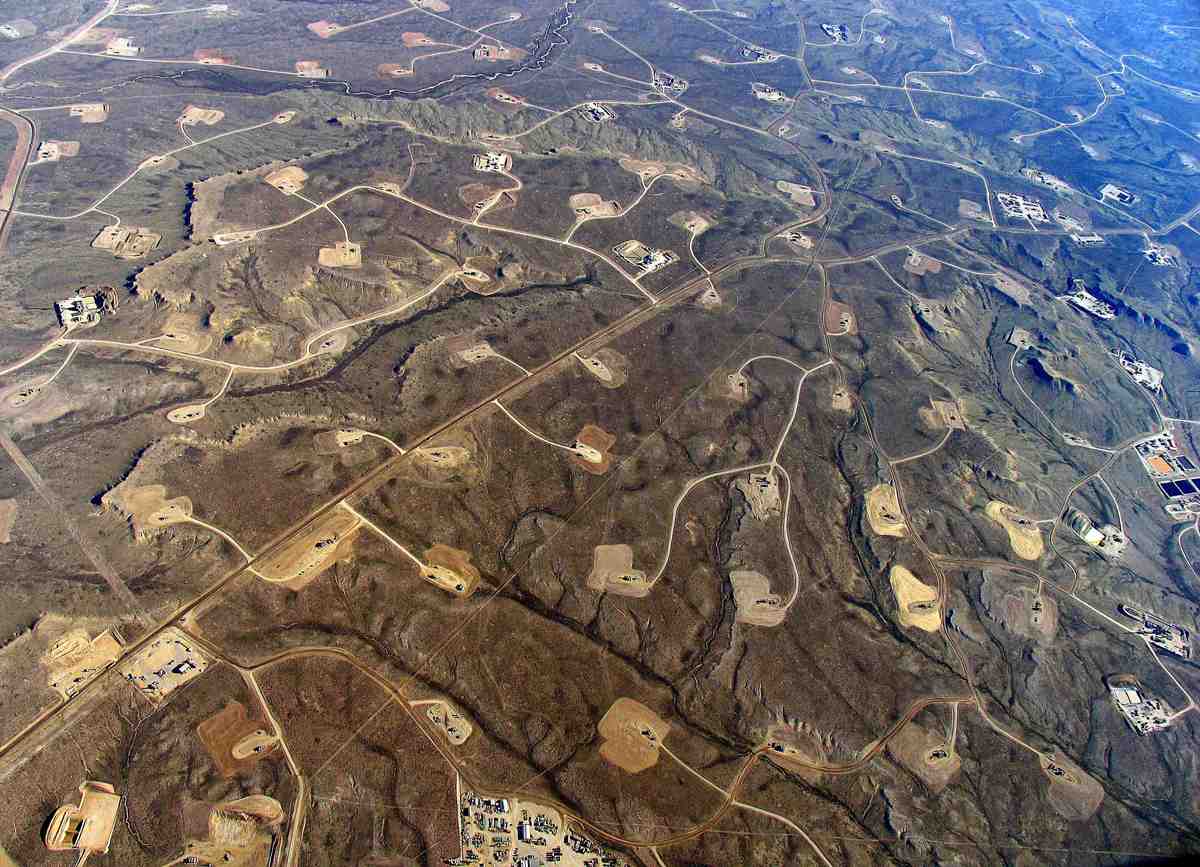Drilling in the dark: Biological impacts of fracking still largely unknown

The dense field of natural gas wells in the Jonah Field in Wyoming emphasizes the potential for multiple, overlapping impacts of hydrofracking on wildlife.
Photo courtesy of EcoFlight
As production of shale gas soars, the industry’s effects on nature and wildlife remain largely unexplored, according to a study by a group of conservation biologists published in Frontiers in Ecology and the Environment on August 1.
The report emphasizes the need to determine the environmental impact of chemical contamination from spills, well-casing failure, and other accidents.
“We know very little about how shale gas production is affecting plants and wildlife,” says author Sara Souther, a conservation fellow in the Department of Botany at the University of Wisconsin–Madison. “And in particular, there is a lack of accessible and reliable information on spills, wastewater disposal and the chemistry of fracturing fluids. Of the 24 U.S. states with active shale gas reservoirs, only five maintain public records of spills and accidents.”

Sara Souther
The 800 percent increase in U.S. shale gas production between 2007 and 2012 is largely due to the use of hydraulic fracturing. Also called fracking, the process uses high-pressure injection of water, laden with sand and a variety of chemicals, to open cracks in the gas reservoir so natural gas can flow to the well. A similar technique is used for extracting oil from “tight” geologic formations.
The chemical makeup of fracturing fluid and wastewater, which can include carcinogens and radioactive substances, is often unknown. The authors reviewed chemical disclosure statements for 150 wells in three top gas-producing states and found that, on average, two out of three wells were fractured with at least one undisclosed chemical.
Pressured by growing concern about pollution to groundwater and surface water, government and the industry have made some steps toward openness, Souther acknowledges, but she says more progress is needed.
“The Pennsylvania Department of Environmental Protection’s website is one of the nation’s best sources of publicly available information on spills of fracking fluid, wastewater, and other contaminants. Even so, gas companies failed to report over one third of spills in the last year,” she says. “How many more unreported spills occurred, but were not detected during well inspections? We need accurate data on the release of fracturing chemicals into the environment before we can understand impacts to plants and animals.”
Government and the industry have made some steps toward openness, Souther acknowledges, but she says more progress is needed.
One of the greatest threats to animal and plant life identified in the study is the cumulative impact of rapid, widespread shale development, with each individual well contributing collectively to air, water, noise and light pollution.
“The past has taught us that environmental impacts of large-scale development and resource extraction, whether coal plants, large dams or biofuel monocultures, are more than the sum of their parts,” notes Morgan Tingley, a researcher from University of Connecticut. “We can’t let shale development outpace our understanding of its environmental impacts.”
“If you look down on a heavily fracked landscape,” Souther says, “you see a web of well pads, access roads, and pipelines creating islands out of what was, in some cases, continuous habitat. What are the combined effects of numerous wells and their supporting infrastructure on wide-ranging or sensitive species, like the pronghorn antelope or the hellbender salamander?
“I am from West Virginia, which is underlain by one of the largest shale gas reservoirs in the U.S. However, this industry doesn’t just impact gas-producing states. Here in Wisconsin, shale development is affecting areas that supply sand for use in hydraulic fracturing.”
“We need accurate data on the release of fracturing chemicals into the environment before we can understand impacts to plants and animals.”
Sara Souther
The study looked broadly at what is known — and what is not — about the conservation impacts of fracking. “Some of the wells in the chemical disclosure registry were fractured with fluid containing 20 or more undisclosed chemicals,” says co-author Kimberly Terrell, a researcher at the Smithsonian Conservation Biology Institute. “This is an arbitrary and inconsistent standard of chemical disclosure.”
With shale gas production projected to increase exponentially over the next 30 years, the authors hope the study will guide the application of limited scientific resources to the most important questions, and enhance cooperation among scientists, industry and policymakers to minimize damage to the natural world.
The authors are all David H. Smith Conservation Research Fellows, a project established by the Cedar Tree Foundation and the Society for Conservation Biology. Souther has been a research fellow at UW–Madison for three years. In September, she will begin a professorship at West Virginia Wesleyan College in West Virginia.
Tags: energy, environment, plants, wildlife



